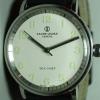-
Similar Content
-
Recently Browsing
- No registered users viewing this page.
-
Topics
-
Posts
-
By Neverenoughwatches · Posted
I think we've talked about this before, using a new mainspring to initially overcome the effects of more movement friction than there should be. The aim is to reduce all going friction not to push through the friction with more torque, that in the long run will create more wear. -
Sensible precautions @rjenkinsgb. I remember as a lad, my mate's dad ran a garage. I can clearly remember watching him change break pads. He used an airline to blow the dust out, (when pads used asbestos), and we used to practically bathe in "carbon tet". But then he did smoke about 40 cigs a day. Makes me shudder to think about it.
-
By nevenbekriev · Posted
OK, a little bit more from today's lecture about the main springs. Generally, the spring in the barrel is limited and can't unwind fully. With the blue line is shown the reserve/torque relation when spring unwinding is limited by the barrel. The green line represents the same when the spring is free to unwind fully And the red line shows the minimum torque that is needed for the movement to keep running. The yelow graph shows how the torque changes (from the blue) when the spring gets weaker (set) after 100 years of work. The purple line represents thinner and longer spring in the same barrel. As You can see, using thinner and longer spring will increase the power reserve. The 'set' spring will have the same reserve as a new one with the same sizes, only the amplitude will be just a little smaller. Of course, this is true only when the movement othervice is in good health ( the red line is lo enough) -
By rjenkinsgb · Posted
As long as you don't grind the stuff up and blow it around, you should be fine. Use a dust mask if in doubt. The things I'm very careful of are: Radium lume - even the stuff that is visually completely dead and inert is still highly radioactive; it's the fluorescent part that decays, not the radium. A single speck inhaled or ingested can cause cancer, so store parts in zip bags and wear a dust mask & wipe your work area down after handling anything that uses it. A proper geiger counter is a good investment if you plan on working with vintage watches, so you can check for it & take appropriate precautions. "One dip" & equivalents - the original type & the generic PERC dry cleaning fluid (Tetrachloroethylene / perchloroethylene) which is what the original one dip was mostly made of. That's toxic, a known carcinogen. Use in very good ventilation only & keep it sealed whenever possible. The newer B-Dip is presumably a safer replacement. -
By Neverenoughwatches · Posted
Only 137% ! sounds like you're not putting enough effort in 😆. I would think of it like cogs on pushbike. Fastest speed to the spindle would be largest pulley wheel on the drive and smallest pulley wheel on the driven. If the motor was into a sliding bed you would have 3x4 ? Speeds.
-










Recommended Posts
Join the conversation
You can post now and register later. If you have an account, sign in now to post with your account.
Note: Your post will require moderator approval before it will be visible.